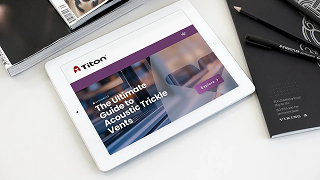Upgrading to metal trickle vents: Enhancing durability and aesthetics
As buildings evolve to meet more stringent standards, the quality and appearance of even the smallest components can make a significant difference. One of these often overlooked components is the trickle vent. While plastic vents have long been the default choice, metal alternatives are gaining traction, offering both functional and aesthetic benefits that better align with modern architectural expectations.
Whether you’re a fabrication product manager or a contractor balancing performance, costs, and client expectations, understanding why metal vents are growing in popularity could give you a competitive edge when you respond to your next tender.
Built to last: the durability case for metal vents
Durability is a non-negotiable requirement in modern construction. Window and door systems need to withstand years of wear and exposure to the elements without compromising performance or visual appeal.
Plastic trickle vents, while cost-effective initially, can degrade over time. UV exposure can cause discolouration, and vents in high-traffic or exposed areas may crack, warp, or become brittle. These defects not only compromise the vent’s function but also detract from the overall look of the window unit, something increasingly important in a design-conscious market.
Metal vents, on the other hand, offer greater robustness:
- Resistant to warping and cracking even under extreme weather conditions.
- Maintains structural integrity over time, reducing the need for replacements
- Minimal discoloration retain a clean, professional finish for years.
This durability can translate into reduced maintenance costs for property managers and peace of mind for developers - particularly when building regulations emphasise long-term performance and resilience.
Modern design demands: How metal vents enhance aesthetics
The growing emphasis on contemporary architecture means clean lines, precision finishes, and consistency across building components have never been more important. Plastic vents can sometimes interrupt this vision, protruding noticeably or clashing with premium window frames.
Metal vents blend more naturally with modern profiles:
- Slimline designs sit flush with the window frame, maintaining sleek visual continuity.
- Custom colour options align with anodised or powder-coated window and door systems.
- Refined finishes complement the premium look of high-spec aluminium, composite, or timber window systems.
For developers working on high-end residential blocks or commercial properties, these details can influence buyer perception. Projects like these often demand that every component reinforces the feeling of quality - and vents are no exception.
Performance meets compliance: future-proofing with metal
Beyond aesthetics and durability, functional performance remains a critical driver for choosing ventilation products. The 2021 updates to Approved Document F (ventilation) and the incoming Future Buildings Standard pushed the industry towards higher performance and better air quality standards.
Key regulatory shifts include:
- Improved ventilation performance requirements in new-build dwellings.
- Consideration of overheating risks under Approved Document O.
Metal vents are not only robust; they are precision-engineered to offer consistent airflow, ensuring that ventilation targets are met without risking underperformance, a common concern with ageing or lower-quality plastic options.
Additionally, noise attenuation is increasingly relevant, particularly in urban and mixed-use developments. Some metal vent models integrate sound-reducing elements, offering a combined solution that meets airflow and acoustic requirements.
Sustainability considerations: aligning with environmental goals
Sustainability is now a core priority across the construction sector. Specifiers and developers are under pressure to source products that reduce environmental impact, both in manufacturing and through their operational lifespan.
Metal vents align with this shift in several ways:
- Recyclability: Aluminium and other metals can be recycled repeatedly without degrading in quality.
- Longevity: Longer product lifespans reduce waste and resource consumption over time.
- Supporting a fabric-first approach: Combining durable materials with high ventilation performance complements broader energy efficiency goals.
As the industry works towards net-zero targets and prepares for the 2025 Future Buildings Standard, choosing resilient, low-waste products is becoming as important as achieving airtightness and thermal efficiency.
Making the Switch: A long-term investment
While the upfront cost of metal vents can be higher than plastic, the long-term value proposition is increasingly clear. Developers and contractors stand to benefit from:
- Reduced maintenance costs.
- Improved customer satisfaction due to lasting visual appeal.
- Simplified compliance with evolving ventilation and acoustic standards.
Ultimately, metal vents represent a low-risk, high-reward upgrade—particularly for projects where performance, design integrity, and lifecycle cost are equally critical.
Head of Product Development, Window and Door Hardware
As Head of Product Development for Window and Door Hardware at Titon, Robin leads the company's efforts in designing and enhancing our hardware product ranges. He oversees AREA24, Titon's advanced testing and quality control facility, ensuring that all products meet rigorous performance and safety standards.
You can find Robin on
LinkedIn.


